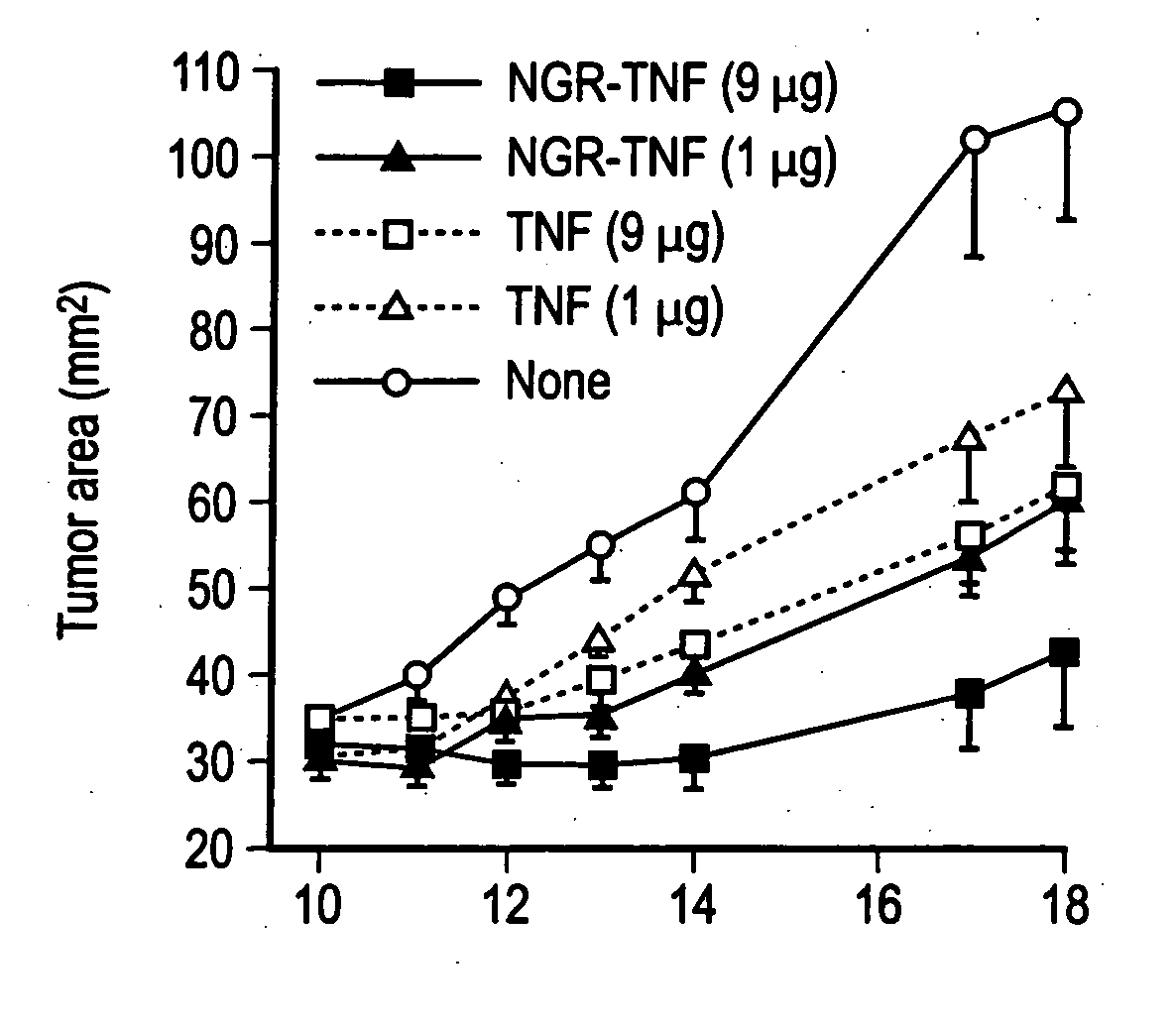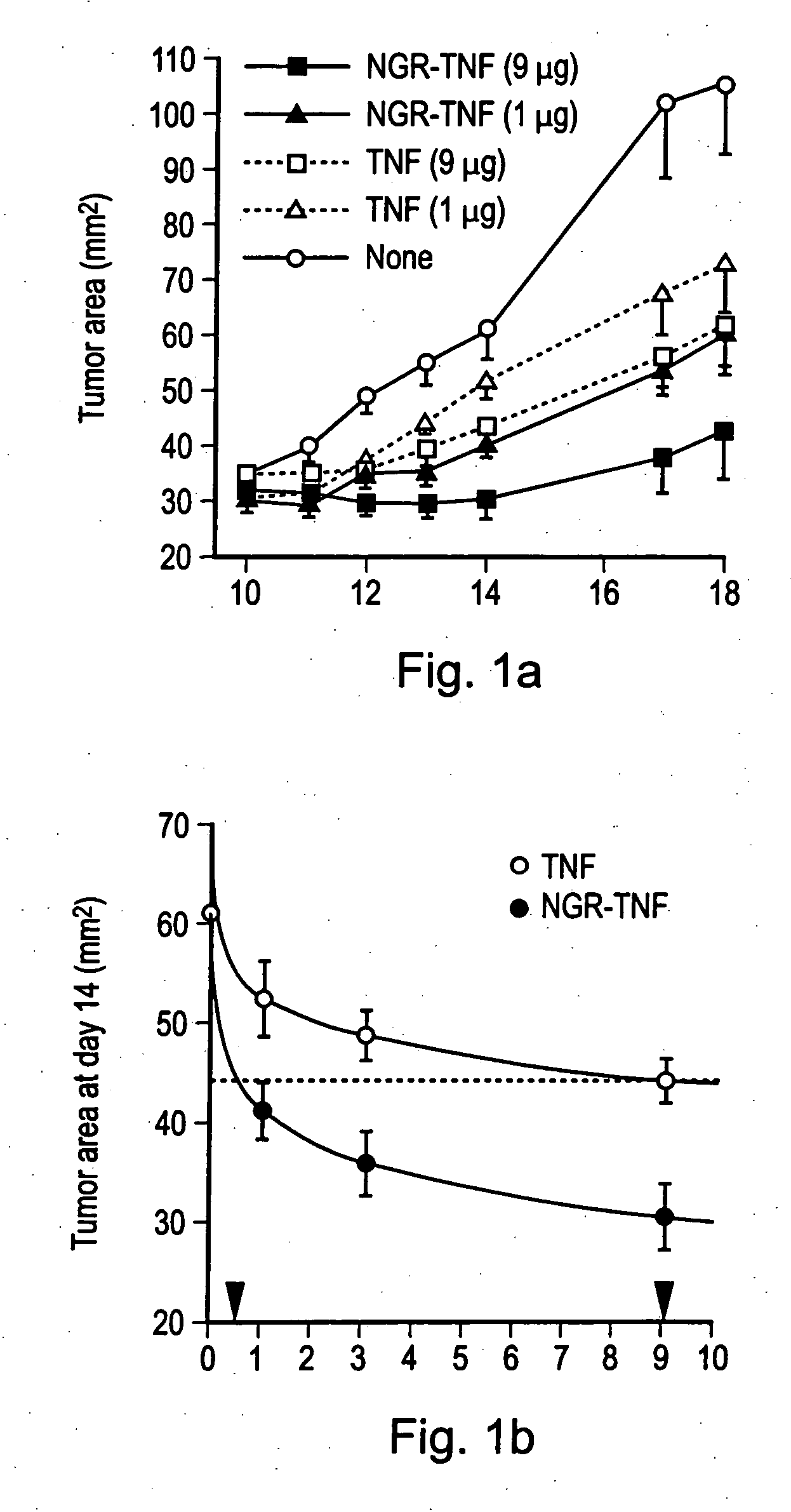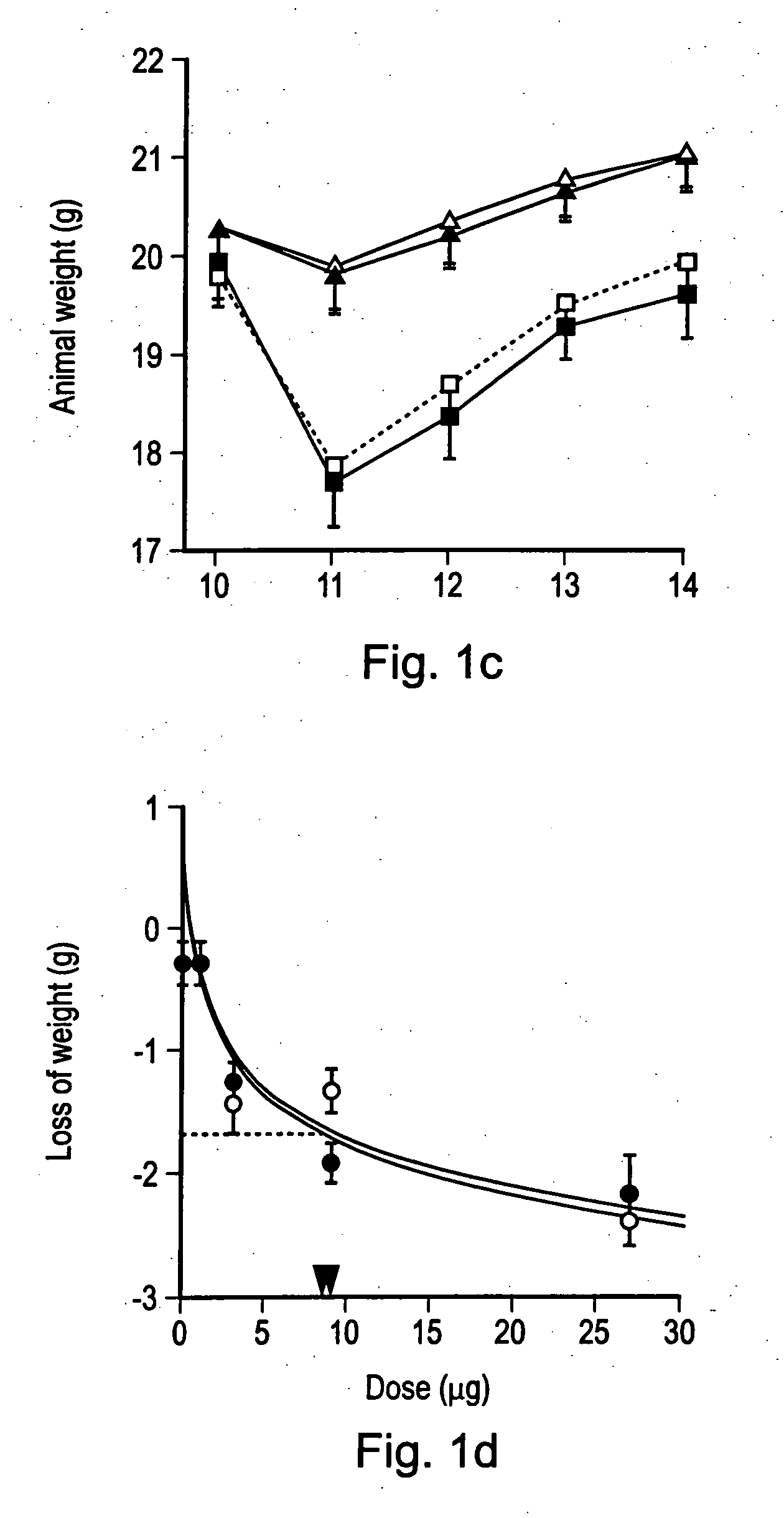Modified cytokines for use in cancer therapy
a technology of cytokines and cancer, applied in the field of modified cytokines, can solve the problems of dangerously affecting the human body, strong limitation in the therapeutic use of cytokines, etc., and achieve the effects of improving the therapeutic index of certain cytokines, effective anti-tumor activity, and improving immunotherapeutic properties
- Summary
- Abstract
- Description
- Claims
- Application Information
AI Technical Summary
Benefits of technology
Problems solved by technology
Method used
Image
Examples
example i
[0110] Preparation of Murine TNF and NGR-TNF
[0111] Murine recombinant TNF and Cys-Asn-Gly-Arg-Cys-Gly-TNF (NGR-TNF) (SEQ ID NO: 18) were produced by cytoplasmic cDNA expression in E. coli. The cDNA coding for murine Met-TNF1-56 (20) was prepared by reverse transcriptase-polymerase chain reaction (RT-PCR) on mRNA isolated from lipopolysaccharide-stimulated murine RAW-264.7 monocyte-macrophage cells, using
5′-CTGGATCCTCACAGAGCAATGACTCCAAAG-3′(SEQ ID NO:7)and5′-TGCCTCACATATGCTCAGATCATCTTCTC-3′,(SEQ ID NO:8)as 3′ and 5′ primers.
[0112] The amplified fragment was digested with Nde I and Bam HI (New England Biolabs, Beverley, Mass.) and cloned in pET-11b (Novagen, Madison, Wis.), previously digested with the same enzymes (pTNF).
[0113] The cDNA coding for Cys-Asn-Gly-Arg-Cys-Gly-TNF1-56 (SEQ ID NO: 18) was amplified by PCR on pTNF, using 5′-GCAGATCATATGTGCAACGGCCGTTGCGGCCTCAGATCATCTTCTC-3′ (SEQ ID NO: 9) as 5′ primer, and the above 3′ primer. The amplified fragment was digested and clone...
example ii
[0119] In Vitro Cytotoxic Activity of Murine TNF and NGR-TNF
[0120] The bioactivity of TNF and NGR-TNF was estimated by standard cytolytic assay based on L-M mouse fibroblasts (ATCC CCL1.2) as described (23). The cytolytic activity of TNF and NGR-TNF on RMA-T cells was tested in the presence of 30 ng / ml actinomycin D. Each sample was analyzed in duplicate, at three different dilutions. The results are expressed as mean±SD of two-three independent assays.
[0121] The in vitro cytotoxic activity of TNF and NGR-TNF was (1.2±0.14)×108 units / mg and (1.8±0.7)×108 units / mg, respectively, by standard cytolytic assay with L-M cells. These results indicate that the CNGRCG (SEQ ID NO: 18) moieties in the NGR-TNF molecule does not prevent folding, oligomerization and binding to TNF receptors.
[0122] In a previous study we showed that RMA-T cells can be killed by TNF in the presence of 30 ng / ml actinomycin D, whereas in the absence of transcription inhibitors these cells are resistant to TNF, eve...
example iii
[0123] Characterization of the Therapeutic and Toxic Activity of Murine TNF and NGR-TNF
[0124] The Rauscher virus-induced RMA lymphoma of C57BL / 6 origin, were maintained in vitro in RPMI 1640, 5% foetal bovine serum (FBS), 100 U / ml penicillin, 100 μg / ml streptomycin, 0.25 μg / ml amphotericin B, 2 mM glutamine and 50 μM 2-mercaptoethanol. RMA-T was derived from the RMA cell line by transfection with a construct encoding the Thy 1.1 allele and cultured as described (14).
[0125] B16F1 melanoma cells were cultured in RPMI 1640, 5% FBS, 100 U / ml penicillin, 100 μg / ml streptomycin, 0.25 μg / ml amphotericin B, 2 mM glutamine, 1% MEM non essential amino acid (BioWhittaker Europe, Verviers, Belgium).
[0126] In vivo studies on animal models were approved by the Ethical Committee of the San Raffaele H Scientific Institute and performed according to the prescribed guidelines. C57BL / 6 (Charles River Laboratories, Calco, Italy) (16-18 g) were challenged with 5×104 RMA-T or B16F1 living cells, respe...
PUM
| Property | Measurement | Unit |
|---|---|---|
| mass | aaaaa | aaaaa |
| pH | aaaaa | aaaaa |
| weight | aaaaa | aaaaa |
Abstract
Description
Claims
Application Information
 Login to View More
Login to View More - R&D
- Intellectual Property
- Life Sciences
- Materials
- Tech Scout
- Unparalleled Data Quality
- Higher Quality Content
- 60% Fewer Hallucinations
Browse by: Latest US Patents, China's latest patents, Technical Efficacy Thesaurus, Application Domain, Technology Topic, Popular Technical Reports.
© 2025 PatSnap. All rights reserved.Legal|Privacy policy|Modern Slavery Act Transparency Statement|Sitemap|About US| Contact US: help@patsnap.com



